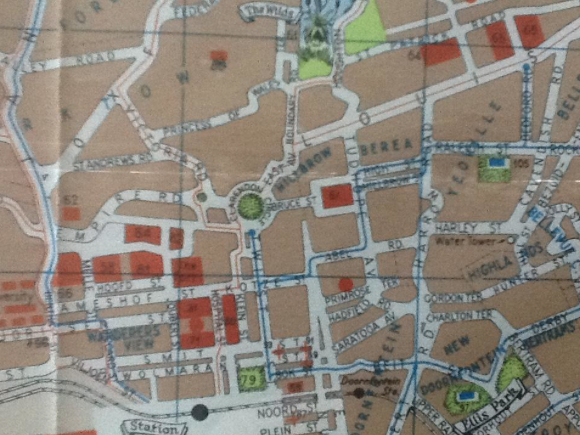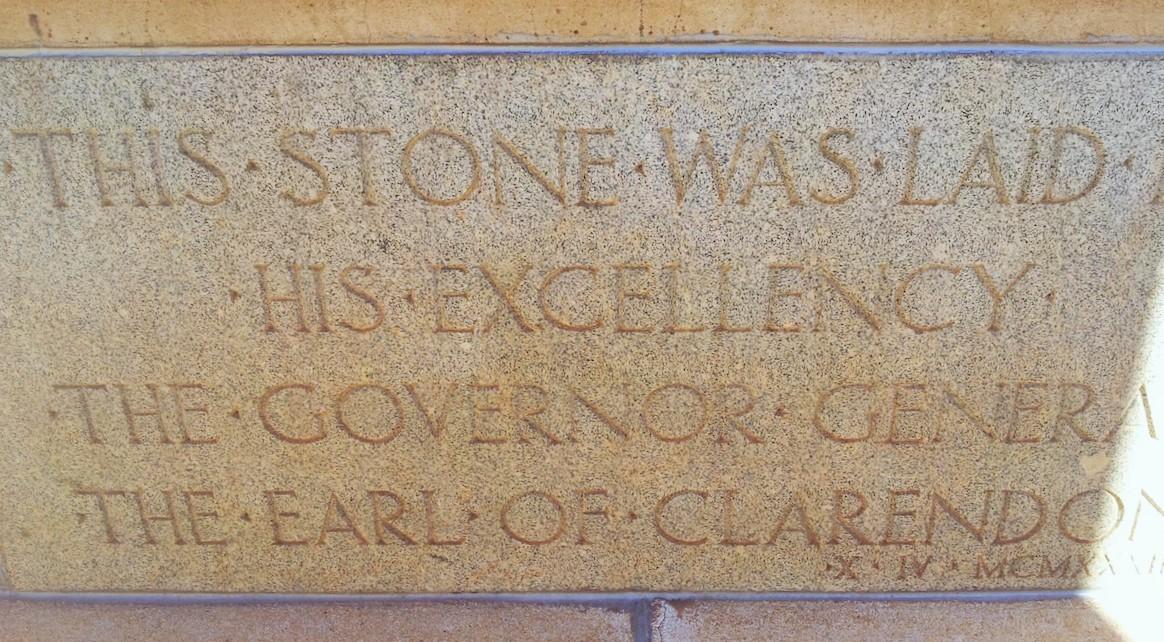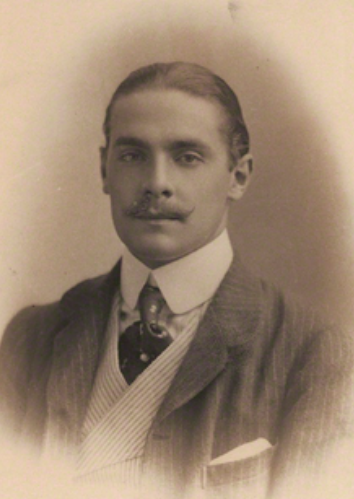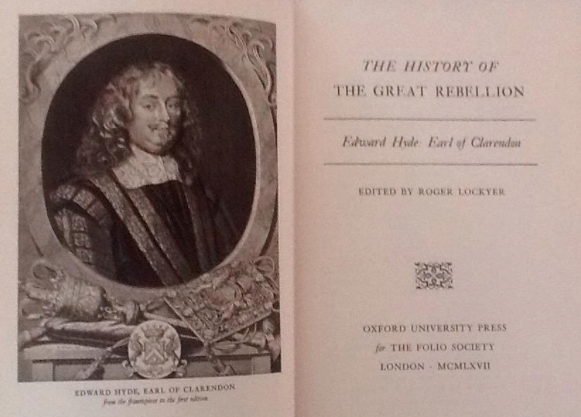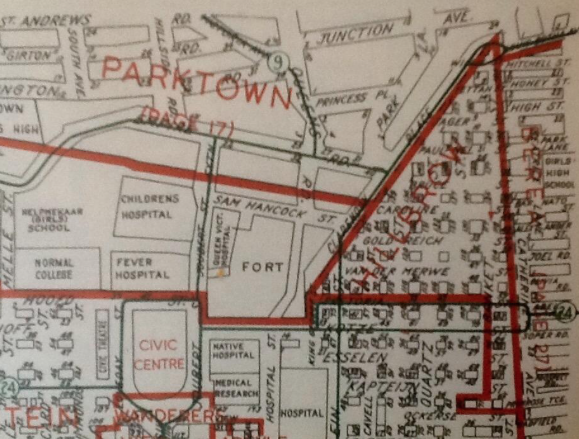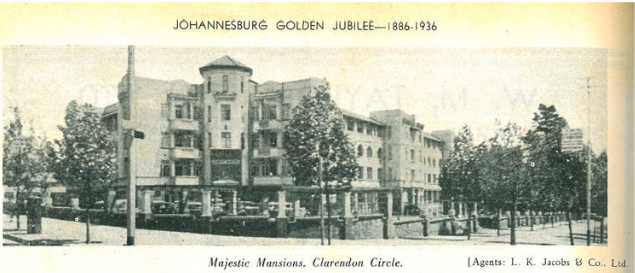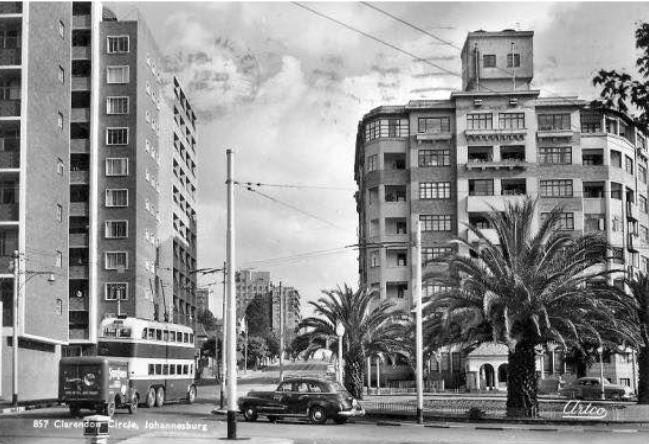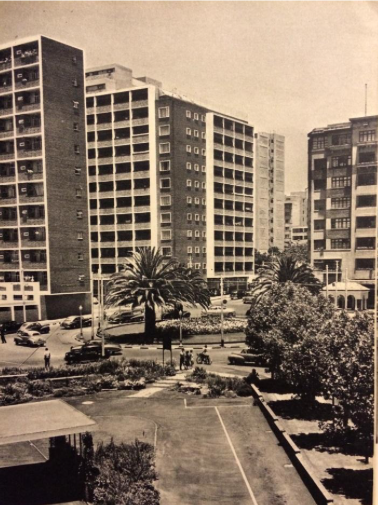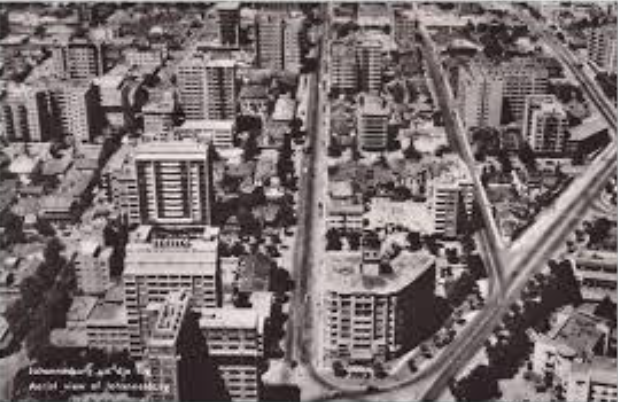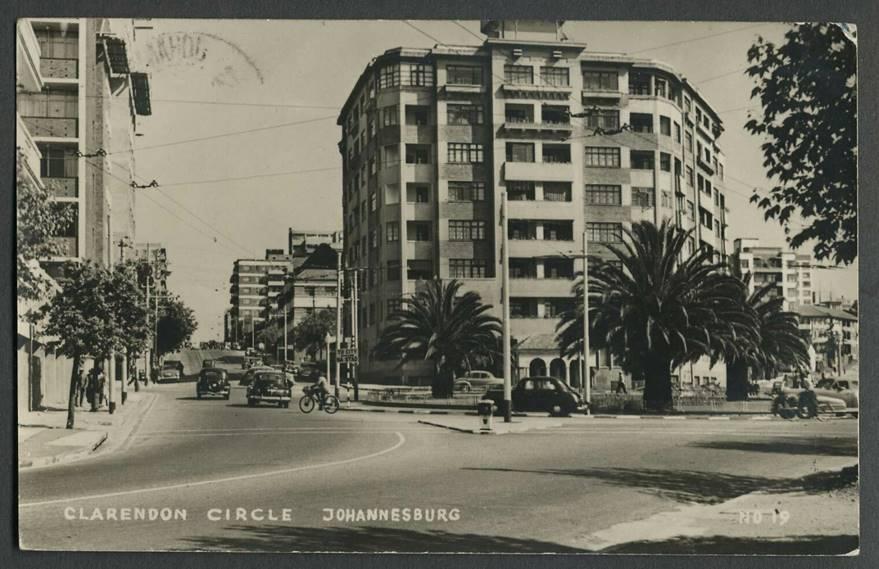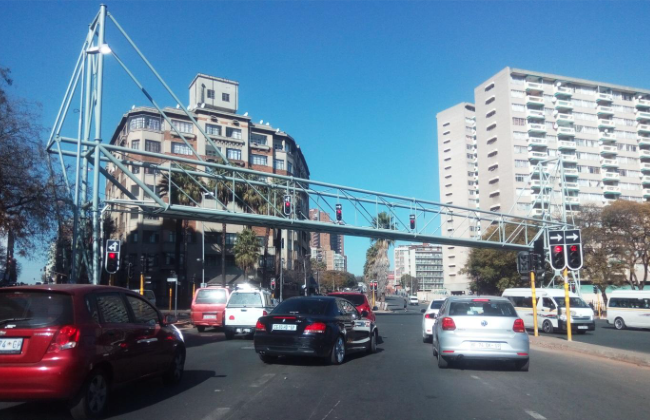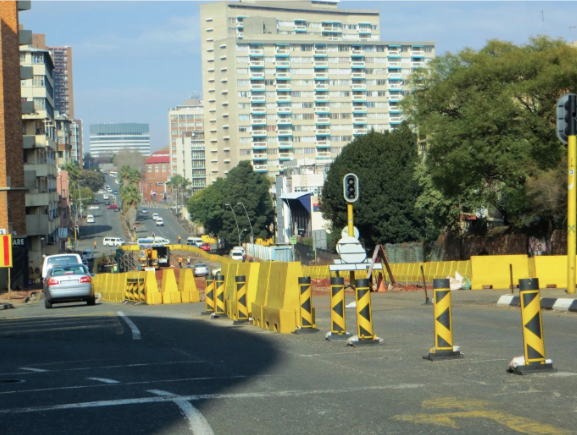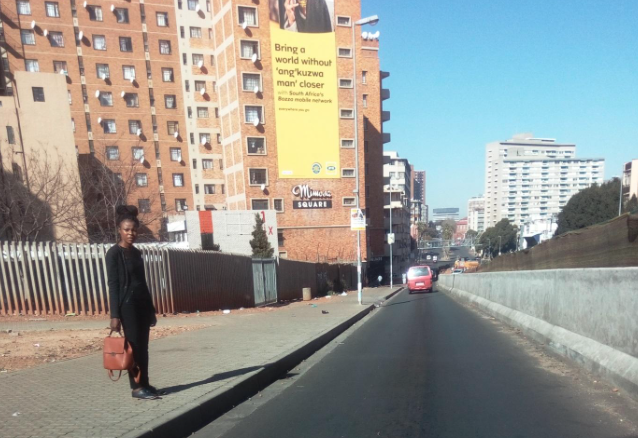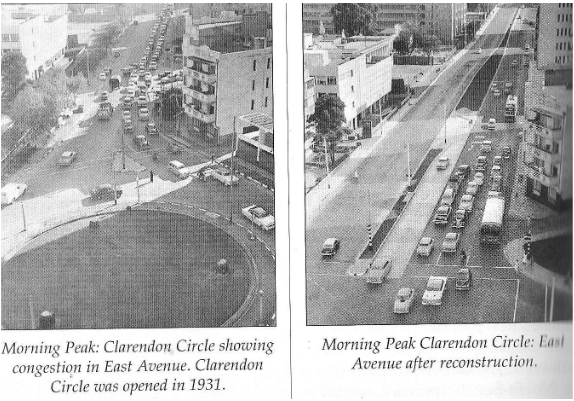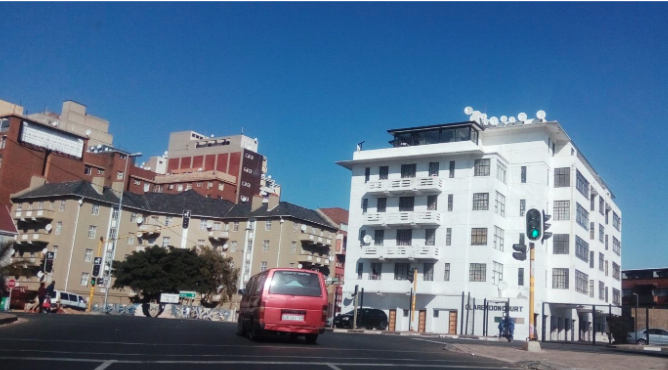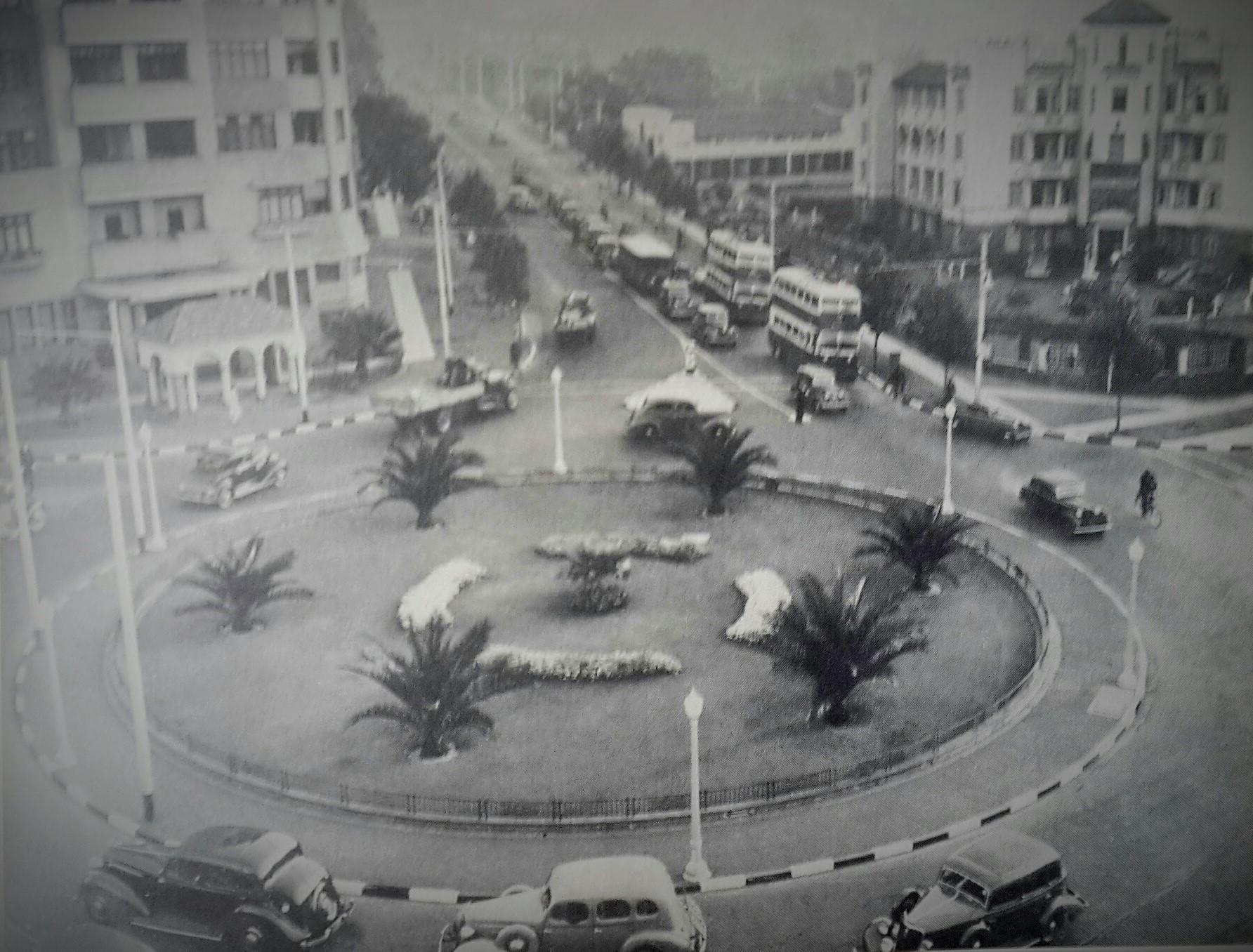
Disclaimer: Any views expressed by individuals and organisations are their own and do not in any way represent the views of The Heritage Portal. If you find any mistakes or historical inaccuracies, please contact the editor.
Clarendon Circle was a landmark intersection of the north east route into Johannesburg. It was a circle of note located where East Avenue crossed Empire, Bruce, Twist and Klein Streets. There was an island on East Avenue separating the traffic lanes with an attractive line up of palm trees and shrubs.
Today Clarendon Circle is no more and the fingerprint of the history is captured in the name Clarendon Place which was the new name for East Avenue. The old Clarendon Circle disappeared into an amorphous, chaotic crossing marked by what we call robots and others around the world call traffic lights. This article explores the history of place and location.
Location of Clarendon Circle (A mid 1950s tourist map of Johannesburg)
Clarendon Circle was named in honour of the Earl of Clarendon, George Villiers (1877-1955) who served as Governor General of the Union of South Africa from 1931 to 1937. He was the chief representative of Britain in South Africa. George Villiers came from an aristocratic English family with ancient roots. His full name was George Herbert Hyde Villiers, 6th Earl of Clarendon. He was a British Conservative politician and sat in the House of Lords. He also served as Chief Scout of the Boy Scout movement during his tenure as Governor General and filled many other public positions and roles. Today Clarendon, the last Englishman to hold the post of Governor General of South Africa, is a largely forgotten figure from our colonial past. However, his name is still remembered in hotels, streets, guesthouses, apartment blocks and schools throughout South Africa. I recall that he was the man who laid the foundation stone of the William Cullen Library at the University of the Witwatersrand in 1935.
The Foundation stone of the William Cullen Library (The Heritage Portal)
George Herbert Hyde Villiers, 6th Earl of Clarendon
Sadly, while in South Africa, Clarendon lost his eldest son, George Villiers, Lord Hyde, in a shooting accident in 1935 on the De Beers Estate in Kimberley (he was only 28).
The royal connections of this family went deep. The first Earl of Clarendon, Edward Hyde (1609-1674) was an English statesman who loyally served Charles II. He was an historian of note and authored the most important contemporary history of the English Civil War of the 1640s, The History of the Rebellion, a book which is still in print. The first Earl of Clarendon was the maternal grandfather of two monarchs: Queen Mary II and Queen Anne.
Frontispiece of the 1st Earl of Clarendon's masterpiece The History of the Great Rebellion, first published in 1702. (A quick photo from my Folio society edition of this book published 1967)
So much for the man, what of our familiar street Clarendon Place which was once Clarendon Circle. Anna Smith, in her classic Johannesburg Street Names gives a full record of City Council deliberations for 1931. In October 1931 the Council decided on the name Clarendon Circle following a suggestion by Councillor D W Mackay (Mayor, 1936-37) that the roundabout should be named Clarendon Circus which was then modified by Councillor M Freeman (Mayor 1934-35) to Place or Circle. The actual planning of a crucial road intersection in the form of a roundabout went back to 1929 in deliberations of the City Engineers Department. The term circus is of English derivation for a traffic roundabout, as in Piccadilly Circus (created in 1910) or Oxford Circus which has 19th century roots. There is an even earlier origin going back to Roman times of a circus being a circular line captured within an arena and giving rise to another expression and entomological root on the phrase “bread and circuses”.
Clarendon Circle was a key intersection leading into the city, or to Hillbrow or west along Empire Road, and served this purpose over a 28 year period. A circle meant that vehicles took turns to enter the traffic roundabout and then move off in the chosen direction of the driver. In 1959 it was decided to abandon the circle in favour of a straightforward intersection to handle growing traffic densities. Over time “traffic” took precedence over a living green urban environment. However, the name Clarendon was retained as what had been East Avenue was renamed Clarendon Place and extended beyond the old circle and headed towards Klein Street.
Holmden’s 1970 Map of Hillbrow. See if you can spot Clarendon Place.
The ultimate photo of modernity in Johannesburg of the thirties (Lost Johannesburg)
The photograph above dates from 1938. Majestic Mansions now demolished is on the right. On the left is Circle Court, an Obel and Obel designed building dating from circa 1935/36. Note the tram terminus in front of Circle Court. Also note the Circle with flower beds and palm trees and rather elegant street lights. The double decker trolleybuses date from post 1935. Twist Street was a principal road into the city and trams ran down the street as far as Clarendon Circle and hence the very attractive tram terminus structure.
Close up view of Majestic Mansions. The building was demolished 1971. (Johannesburg Golden Jubilee 1886-1936)
Clarendon Circle during the 1950s (Image from the SAR and H collection featured in Great Cities of the World by W A Robson)
Another shot of Clarendon Circle in the 1950s (Artco)
Note the trolleybus and the overhead trolley wires in the image above. The palm trees have grown and Circle Court is still there. Twist Street was and still is a main thoroughfare, though today it is a one way street through Hillbrow.
View of Clarendon Circle looking down from Park Lane (Photo sourced by Marc Latilla)
Aerial view of Hillbrow in 1953
In the image above, Twist Street is to the left of Circle Court and Clarendon Place is to the right. Notice the narrow streets and the trees on the urban landscape. Circle Court dominates its small triangle stand. The official address of Circle Court is 2 Bruce Street but the name Circle Court reflects its locational relationship to Clarendon Circle. What has happened to our Urban forest?
Old postcard of Circle Court
Circle Court and Majestic Towers & Majestic Gate (Kathy Munro)
This image was taken on the 26 July 2018. Circle Court is still there and has a blue plaque. The high rise twin blocks of Majestic Towers and Majestic Gate stand where Majestic Mansions once was. Cars and minibus taxis create a cacophony of traffic. I am trying to catch a photo of the moment and about to negotiate crossing into Empire Road at the traffic light turning right. You change lanes at your peril.
Can someone explain the purpose of the fanciful overhead steel frame now spanning what was once Clarendon Circle? It’s not a bridge, it’s not a pedestrian walkway, it’s not a climbing frame for urban early morning exercise, it’s not a lighting network, it’s not an innovative traffic light. Well, what is it? Why do we need it? Whoever positioned this obviously expensive item of grandiose engineering does not have a clue about architecture, heritage, a harmonious cityscape or a sense of place and human belonging.
A view of Clarendon Place in 2015 (Kathy Munro)
The construction work pictured above in 2015 forms part of the 'Corridors of Freedom'. The objective of the project appears to be to densify city population settlement along the principal long transport corridor and to provide a rapid, cost effective public transport system. The idea is that this will banish the private one person driver in a sedan car (like me!) and bring the city to the people and the people to the city as one promotional blurb breathlessly punts.
Clarendon place in July 2018 and the commuter of the future (Kathy Munro)
Despite the investment in infrastructure, there is no BRT and the taxis are the dominant form of transport. The old Mimosa Hotel is now Mimosa Square. Taxis stop to pick up this passenger. We have yet to see a functioning Rapid Bus Transport service. There are concrete barriers and bollards changing the scale of the streetscape. There is no longer an island down Clarendon Place just an incredibly alien line up of cement blocks rising to a metre and higher and creating a narrow corridor for a single line of vehicles, taxis and private cars. The “corridor of Freedom” is a complete misnomer. This is far worse than the situation of 1931.
Before and after reconstruction (sourced by Marc Latilla)
An on the go shot of Clarendon Court located at the intersection of Boundary Road, Banket Street and Louis Botha Avenue (Kathy Munro)
The image above shows two imposing residential heritage buildings. As you approach Clarendon Place from Louis Botha avenue you can see Ridgeview and Clarendon Court, both buildings spruced up and repainted. Clarendon Court has been fenced and the result of the road changes is that this apartment block is stranded on an island. The Dolls House Berea Fire station is just out of sight on the left hand side.
I recommend that our city gives some thought to its past as well as its future and stop trying its sleight of hand. How extraordinary that having dismantled the streetscapes and public space trees that were slowly nurtured and layered over a hundred years of history, we now have a concrete, tar, and steel world in a ‘Corridor of Freedom’. It is at this point that the City then commissions spurious exercises in acknowledging “heritage“.
Kathy Munro is an Honorary Associate Professor in the School of Architecture and Planning at the University of the Witwatersrand. She enjoyed a long career as an academic and in management at Wits University. She trained as an economic historian. She is an enthusiastic book person and has built her own somewhat eclectic book collection over 40 years. Her interests cover Africana, Johannesburg history, history, art history, travel, business and banking histories. She researches and writes on historical architecture and heritage matters and is well known for her magnificent book reviews. She is a member of the Board of the Johannesburg Heritage Foundation and is a docent at the Wits Arts Museum. She is currently working on a couple of projects on Johannesburg architects and is researching South African architects, war cemeteries and memorials.
Comments will load below. If for any reason none appear click here for some troubleshooting tips. If you would like to post a comment and need instructions click here.

